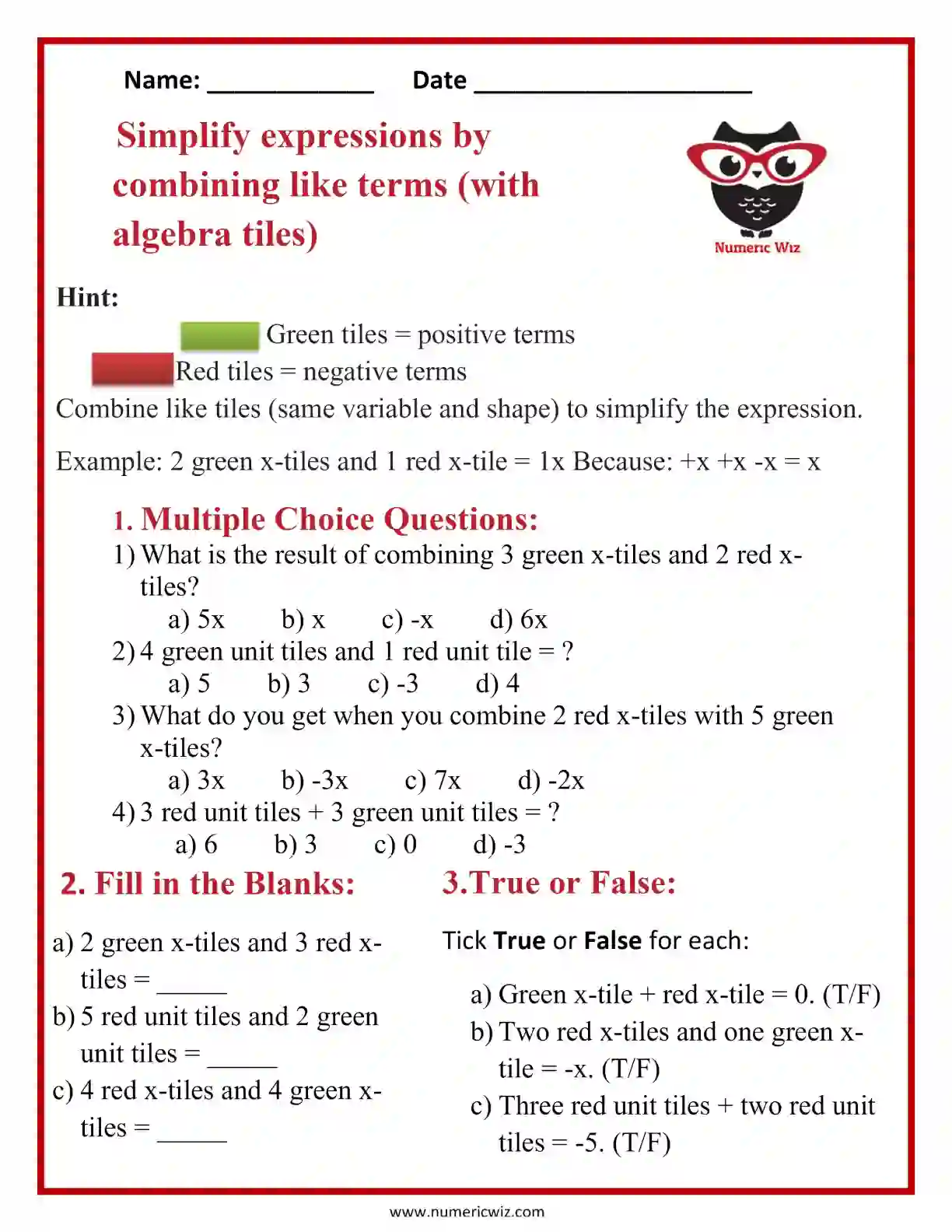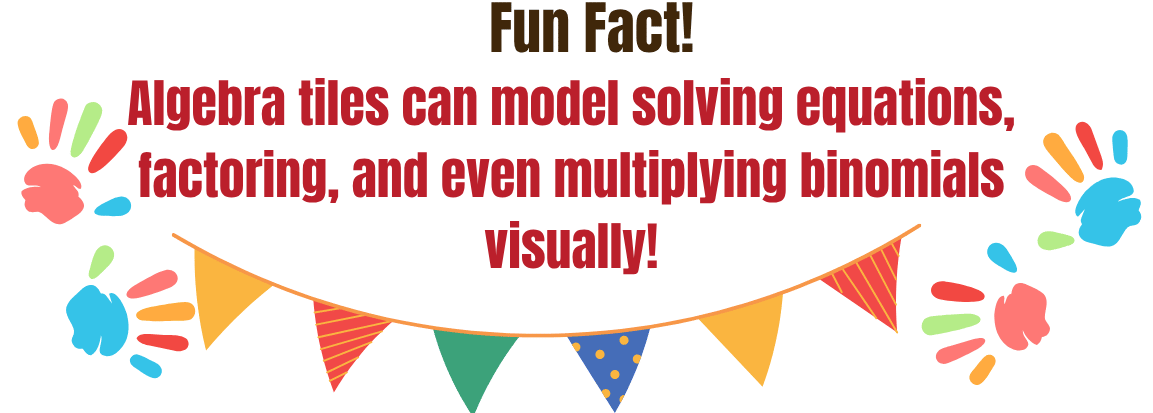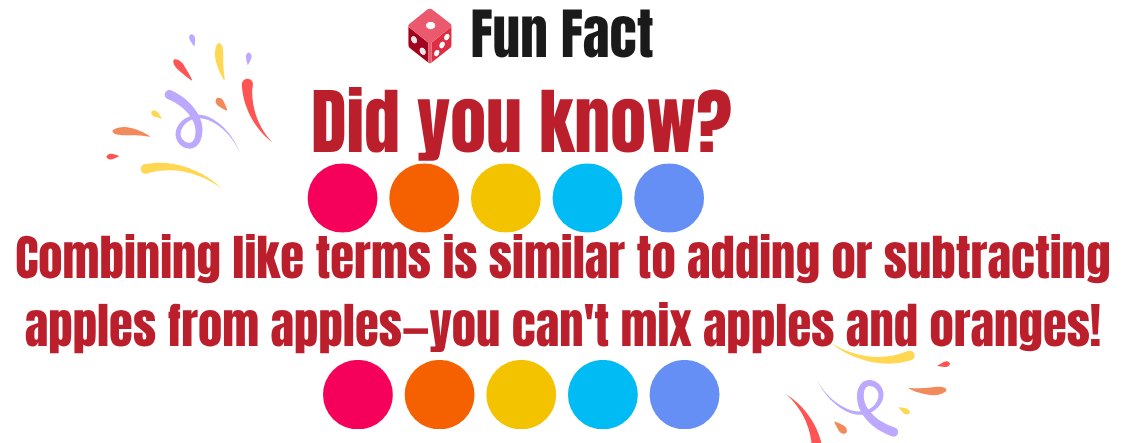Recognize like terms using algebra tiles
Combine positive and negative terms visually and algebraically
Build foundational skills for solving algebraic equations
Strengthen number sense with integer operations

Why do so many students freeze when faced with a messy algebraic expression? This worksheet turns that confusion into clarity with the magic of algebra tiles. Designed to build confidence through visuals, it helps students master combining like terms—one tile at a time.
Combining Like Terms with algebra tiles is a strategy used in algebra to simplify expressions by grouping similar variables or constants. Algebra tiles represent variables and constants as visual blocks, making abstract ideas feel more concrete. The concept has grown over time from chalkboard scribbles to interactive teaching aids. Today, it’s foundational in middle school math classrooms.

Equivalent expressions are algebraic phrases that may look different but hold the same value when simplified. For example, 2x + 3x and 5x are equivalent because they simplify to the same result. Combining like terms—grouping terms with the same variable part—is key to making expressions simpler and solving equations efficiently.
Historically, the idea of expressing the same value in multiple ways dates back to early Arabic and Greek mathematicians who used visual methods, much like algebra tiles, to explain abstract equations. Today, algebra tiles serve as a concrete tool to teach middle schoolers, especially in 7th grade, how to spot and group similar elements in an expression. This tactile approach helps bridge the gap between visual learning and abstract reasoning.
If Ali owes 3 red x-tiles (–3x) and earns 5 green x-tiles (+5x), what is the simplified expression?
(+5x) + (–3x) = 2x
So, Ali ends up with 2x.x
Have you ever looked at an algebraic expression and wondered why it seems so complicated? The secret lies in understanding how to combine like terms. In algebra, this means grouping together terms with the same variables and exponents—like turning 3x + 5x into the cleaner, simpler 8x. It’s not just a math trick; it’s a core algebraic skill that helps students break down problems into smaller, more manageable steps.
For 7th-grade math students, this concept becomes much clearer with the use of

algebra tiles—a visual, tactile method that turns numbers and variables into physical pieces. Instead of solving abstract equations, learners physically group and cancel out tiles to identify equivalent expressions. This interactive method brings expressions like 2x + x - x to life, allowing students to actually see that it simplifies to 2x. It aligns beautifully with Common Core standards (6.EE.A.3 and 7.EE.A.1) and builds a strong foundation for mastering linear equations, rational coefficients, and multi-step word problems in later grades.
Mastering equivalent expressions isn’t just about solving textbook equations—it’s about applying math to real life. This worksheet aligns with Common Core standards 6.EE.A.3 and 7.EE.A.1, ensuring students build confidence in simplifying expressions, combining like terms, and identifying patterns. With 20+ math problems, learners start with basics like 2x = 10, and gradually tackle multi-step equations involving both integers and variables.
Step 1: Identify the Terms
Look at each part of the expression. For example, in 2x + 3x + 1, spot the variable tiles (x-terms) and unit tiles (numbers). Each x-tile stands for x, and each small square tile stands for 1.
Step 2: Represent with Tiles
Use algebra tiles to model the expression. Lay down 2 x-tiles, 3 more x-tiles, and one small unit tile. Visually grouping these reinforces the concept of like terms.
Step 3: Combine Like Terms
Group all similar tiles. In this case, 2 x-tiles plus 3 x-tiles equals 5x. The unit tile remains as is. You now have an equivalent expression: 5x + 1.
Step 4: Simplify the Expression
Remove zero pairs (if any). Then write the simplified expression. This visual and hands-on method deepens understanding and builds confidence.
Step 5: Apply to Word Problems
Now apply this process to real-world scenarios like budgeting or speed-distance problems. Algebra tiles make abstract concepts concrete, turning math from confusion to clarity.
Students don’t just jump into algebra—they climb it, step by step. This worksheet begins with guided examples, walking learners through how to combine like terms using algebra tiles. Each tile color and shape represents a variable or constant, visually teaching how equivalent expressions form.
As confidence grows, so does independence. The next sections reduce hints and offer slightly harder problems, eventually leading students to design their own expressions. From "2x + x = ?" to "Create an expression where x = 5", students build mastery gradually, one step at a time.
Example 1:
Expression: 2x + 3x
Using tiles: Place 2 x-tiles and 3 x-tiles → Combine to get 5x
Equivalent Expression: 5x
Example 2:

Expression: 4x + 2 + 3x + 1
Tiles used: 4 x-tiles, 3 x-tiles, 2 small tiles, 1 small tile
Combine like terms: 4x + 3x = 7x, 2 + 1 = 3
Simplified Expression: 7x + 3
Example 3 (with negative terms):
Expression: 3x - x + 2
Tiles: 3 x-tiles, 1 negative x-tile, 2 unit tiles
Combine: 3x - x = 2x
Answer: 2x + 2
Example 4 (Real-World):
Problem: “Liam buys 2 pens and 3 more pens later. Each pen costs x dollars.”
Expression: 2x + 3x
Use algebra tiles to represent → Combine → 5x
Conclusion: Liam spent 5x dollars in total.
Math isn’t just numbers—it’s everywhere you look. Whether you're calculating the cost of groceries or figuring out how far a car travels, combining like terms makes it easier to solve problems. Imagine you’re buying 3 packs of markers at x dollars each, and then 2 more. Your total cost? Just combine like terms: 3x + 2x = 5x.
Students use algebra tiles to visualize problems in relatable settings—like measuring field lengths, comparing phone data plans, or splitting restaurant bills. This hands-on method builds a stronger connection between abstract equations and real-world thinking. It turns equivalent expressions into tools for everyday life.
Budgeting: Adding income (+) and debts (–)
Keeping score in games: Gains and losses
Coding: Managing values that increase or decrease
Inventory: Counting and simplifying grouped quantities
Think you’ve cracked it?
Download the worksheet, solve it, and upload your answers to our “Evaluate Your Work” page. Our awesome teachers will check it and send feedback just for you! Homework has never been this fun—or this helpful!
For a limited time
